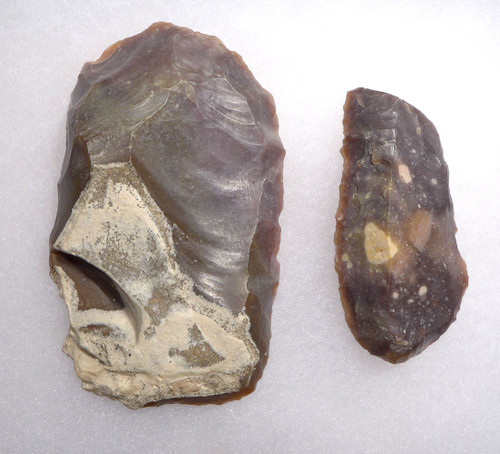Product Description
SEE MORE EUROPEAN NEOLITHIC TOOLS
Masterfully crafted between 5500 and 4500 BC, this MASSIVE red flint UNIFACIAL BLADE KNIFE was most likely a prestige tool from the European Neolithic. It was found in Vailly-sur-Aisne, North Central France, and is attributed to the Linear Pottery Culture that lived in the area during this time. This milestone in European human history represents a major event in the initial spread of agriculture in Europe. The unique red flint was famous from the Indre-et-Loire region of France, since the Lower Paleolithic. This area is in the central part of France, well south of where the blade was found indicating trade and long-distance travel during this Neolithic Period of France.
A blade of this size could have been used to cut large animal hides for leather clothing or goods but it shows little use indicating it could have been a prestige tool. While many Neolithic flint flake tools are rather simplistic in design and were intended for simple, mundane purposes, this is one of the most refined and aesthetic Neolithic flint blade knives we have seen indicating its importance in its day. Original ground minerals and sediment are still intact in hinge fractures - an indicator ONLY seen in AUTHENTIC specimens.
HISTORY
The earliest food-producing communities to appear on the North European Plain were those of the Linear Pottery Culture (also known as Linear Band Ware), which had also colonized the loess belt across central Europe between 5400 and 5000 B.C.. This cultural horizon spread rapidly over large parts of Central and Western Europe during the middle of the sixth millennium B.C., taking with it some of the raw materials from its region of origin in Hungary. There are vast areas in which Linear Pottery settlements have not yet been found.
Permanent settlement is an important feature of these early agriculturalist societies, often providing clear evidence of plant and animal domestication. These peoples built massive timber longhouses for shelter demonstrating the technological advances made during the early Neolithic. Artifacts are often found in or around these dwellings, notably figurines, decorated pottery, carved bone and stone tools.
The ceramics, flint tools, and ground stone tools found on the Linear Pottery sites of the North European Plain are essentially similar to those found elsewhere in east-central Europe. Unlike the large Linear Pottery sites of the loess belt, substantial longhouses have not been found in the lowlands. Instead, most of the lowland Linear Pottery sites are relatively small collections of shallow pits. The pits often have dense concentrations of refuse with relatively large shards and many reconstructable vessels. All the same, they do not appear to represent the same level of commitment to particular settlement locations as do the longhouse settlements of the loess belt.
 US DOLLAR
US DOLLAR
 EURO
EURO
 AUSTRALIAN DOLLAR
AUSTRALIAN DOLLAR
 CANADIAN DOLLAR
CANADIAN DOLLAR
 POUND STERLING
POUND STERLING






















